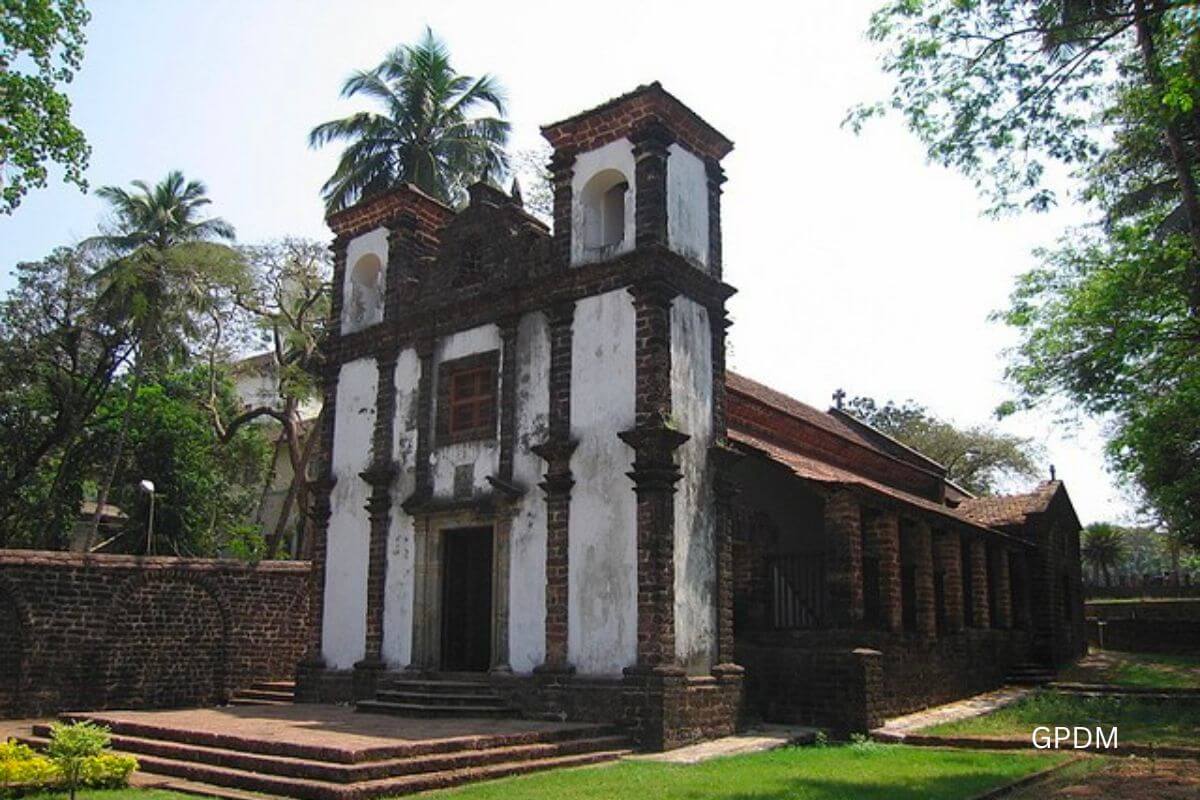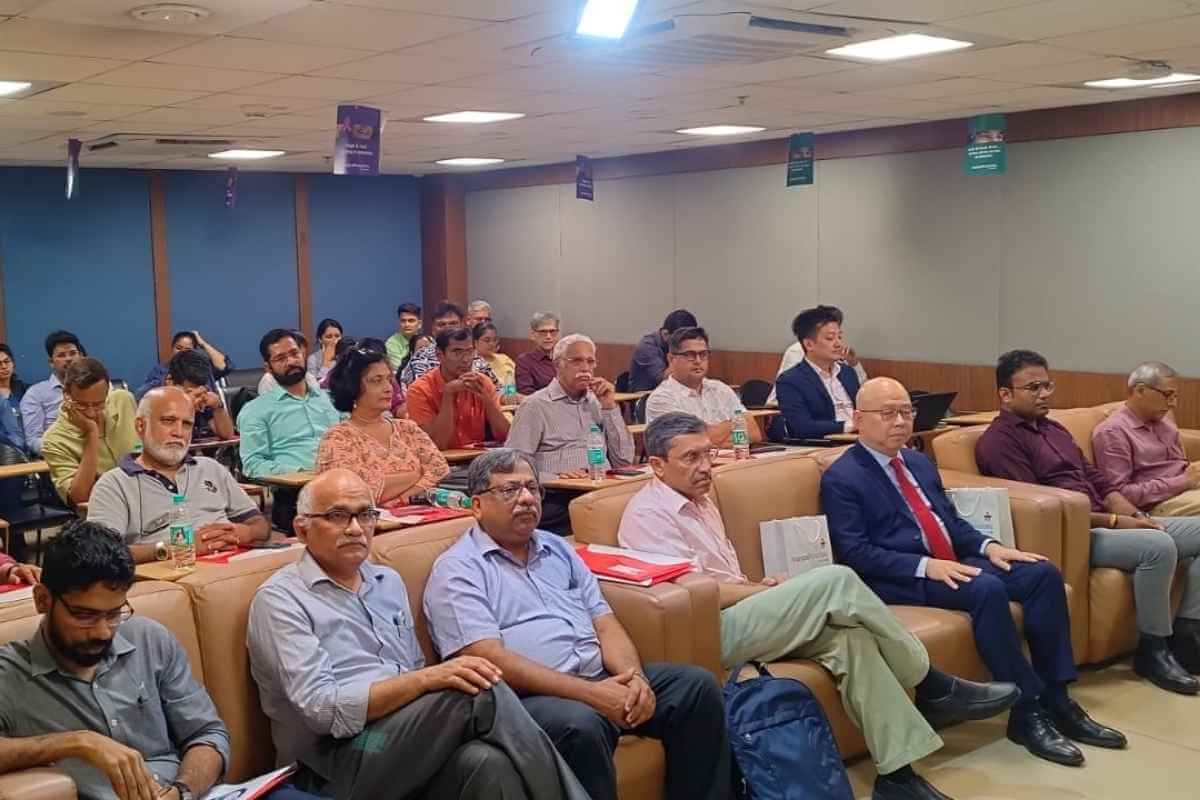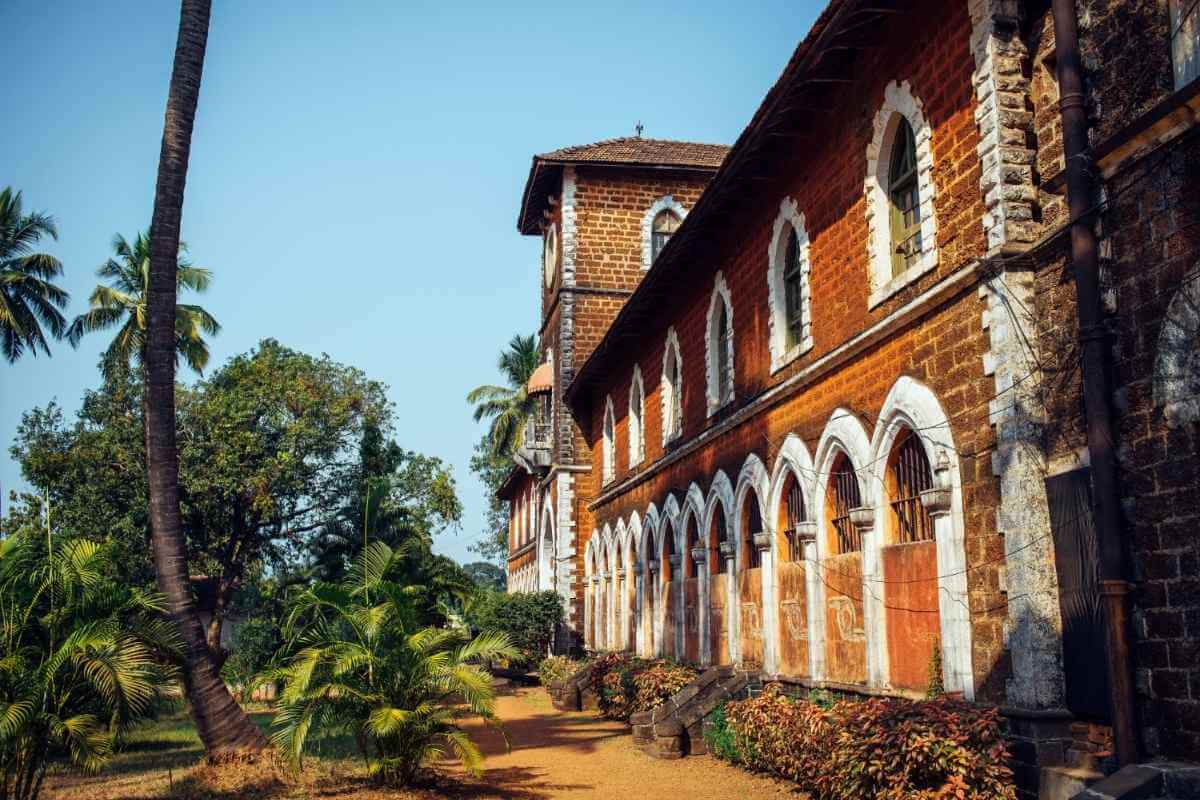Goa, a party destination on the western coast of our nation, is well known for its fantastic beaches, exciting nightlife, and mouthwatering cuisine. Many people don’t realize that Goa also has some of the most beautiful churches in the nation, though. These cathedrals are a tribute to the rich cultural legacy and religious traditions of Goa, with stunning baroque architecture and elaborate embellishments. The year is 2023, and this city of nonstop fun and celebration has successfully preserved its century-old Portuguese colony, attracting eager travelers and guests from virtually every country. For those who are unaware, Goa’s amazing face continues to top a lot of people’s bucket lists even now.
Chapel of St. Catherine, Alexandria
A notable religious building in Assolna, Goa, India is called the Chapel of St. Catherine, often referred to as the Chapel of Santa Catarina. It is devoted to St. Catherine of Alexandria, one of the Fourteen Holy Helpers and the patron saint of unmarried women, scholars, and philosophers.
The church is renowned for its distinctive style, which combines Portuguese and Indian elements. With white walls, a sloping tile roof, and arched openings, it has a straightforward yet endearing style. Icons and religious artwork featuring St. Catherine and other saints decorate the chapel’s interior.
Religious services are held at the Chapel of St. Catherine, which also serves as an area of devotion for the neighbourhood’s Catholics. Visitors who want to learn more about Goa’s religious and cultural legacy are also drawn there. The chapel is attractive in part because of its quiet setting, which makes it a peaceful place for meditation and prayer. The Chapel of St. Catherine provides a window into the cultural and architectural variety of the area, although perhaps not as well recognized as some of the major chapels in Goa. It serves to act as an indication of the importance of Catholicism in Goa historically and culturally, highlighting the blend of Indian and European elements that create the state’s distinct identity.
The Architecture of the Basilica of Bom Jesus
The Chapel of St. Catherine’s architecture, a fusion of Indian and Portuguese styles, exemplifies the cultural influences that have moulded the Goa region throughout the years. The chapel’s noteworthy architectural characteristics are listed below:
- Simplicity: The chapel has a straightforward architectural style that is distinguished by straight lines and no decoration. The goal is to provide a serene, contemplative environment for worship.
- White Walls: A prominent characteristic of Goan churches and chapels is the façade of the building being painted white. White is a hue that denotes purity and is frequently used to describe religious buildings in the area.
- Traditional red clay tiles: are used to cover the chapel’s sloping roof, which is decorated with this feature. The building’s sloping roof enhances its looks while also aiding in efficient rainfall drainage during the monsoon season.
- Arched Windows: The chapel’s windows are usually arched, which gives the building’s design a sense of elegance. These arched windows frequently have artistic accents like elaborate grillwork or stone sculptures.
How to Reach St. Catherine
Getting out at the Karmali Railway Station, which is 3 kilometres from the heart of Old Goa, is the quickest way to get there. Additionally, Panaji, the capital of Goa, is just 9 kilometres distant. Panaji to Old Goa bus service is available.
To go to Old Goa, take a direct bus (Panjim-Ponda/Panjim Old Goa Bus) from the main Panaji bus stop.
30 kilometres separate Old Goa from the Dabolim Airport in Goa, which may be reached by bus or taxi in about an hour. To travel to Old Goa from the airport, you might need to disembark in Panaji and then take a different bus from Panaji to Old Goa.
Royal Chapel of St. Anthony
A famous chapel in the Indian state of Goa is called the Royal Chapel of St. Anthony, often referred to as the Royal Chapel of St. Anthony of Padua. Goa has a long history of Portuguese colonialism, and throughout that time, several churches and chapels were built.
The Ilhas area of Goa’s little settlement of Talaulim is home to the Royal Chapel of St. Anthony. When Goa was ruled by the Portuguese in the 17th century, this structure was constructed. St. Anthony of Padua, a revered Catholic saint famed for his miraculous acts and intercessions, has a chapel in his honor.
The chapel is well known for its exquisite architecture, which combines elements from Portugal and India. It has a straightforward yet attractive front that is whitewashed. There are elaborate altars, holy figures, and bright murals inside that reflect biblical episodes and St. Anthony’s life. Both worshippers and visitors alike visit the Royal Chapel of St. Anthony, which has religious importance for the local Catholic population in Goa. It serves as a site of worship and pilgrimage and symbolizes the region’s rich cultural legacy.
The Architecture of the Royal Chapel of St. Anthony
The chapel’s inside is decorated with religious figures, paintings, and artwork. Colorful paintings representing scenes from the Bible, St. Anthony’s life, or other major religious events may be seen on the ceilings and walls. Statues of several monks and religious leaders are positioned on the altars. The Royal Chapel of St. Anthony’s architecture features a distinctive fusion of Portuguese and Indian architectural elements. It frequently combines Portuguese-imported European architectural styles with Indian elements and workmanship. The resultant combination gives Goan chapels and churches a distinctive aesthetic identity.
The tower is often a distinct building from the main structure and is frequently decorated with elaborate ornamentation. You’ll discover one or more altars honoring various saints inside the church. These altars are frequently beautiful and embellished with fine carvings, golden details, and sacred objects. The core area of the chapels, where everyone congregates for devotion, is typically one nave.
How to Reach the Royal Chapel of St. Anthony
- By Air: Goa International Airport (Dabolim Airport), which is around 25 kilometers from Talaulim, is the closest airport if you’re flying in. You may use a cab or the public transit system to get to the chapel from the airport.
- By Train: Madgaon Railway Station, commonly known as Margao Railway Station, is the closest train station to Talaulim. It has excellent connections to important Indian cities. You may take a cab or a local bus to get to the chapel from the railroad station.
- By Road: Talaulim is conveniently reachable by road. To get to the chapel, you may either take a cab or rent a car. You can utilize State Highway 8 as a navigational aid as it passes close to Talaulim.
Chapel of St Sebastian
The Chapel of St. Sebastian, which dates to the early 19th century, is a significant Fontainhas, Goa, attraction. St. Sebastian, who healed those afflicted by the epidemic and other ailments, is honored by the immaculate white building. The church has a crucifix that depicts Christ looking fearfully into the minds and souls of the perpetrators. Several people come to the church to observe the Feast of Our Lady of Livrament.The chapel’s illustrious past dates to the 19th century. It was built in 1818 and is devoted to St. Sebastian, a martyred Christian and patron saint of those battling the plague. During the colonial era, the chapel functioned as a place of prayer for the neighborhood Catholics.
The church is especially well-known for its yearly celebration of St. Sebastian’s Day on January 20. With processions, music, dancing, and traditional Goan festivals happening close to the church, this colorful event draws both residents and tourists.
The Architecture of the Chapel of St Sebastian
The Chapel of St. Sebastian’s architectural design depicts the blending of cultures that took place in Goa during the Portuguese colonial era. It mixes Portuguese-imported components of European architecture with indigenous Indian workmanship to create a distinctive fusion unique to the area.
You will discover one or more elaborate altars honoring various saints inside the church. The altars are frequently embellished with intricate carvings, golden accents, and saint figures. The chapel’s focal point is often the main altar, which is dedicated to St. Sebastian. The Chapel of St. Sebastian has ornamental elements including floral designs, religious emblems, and elaborate plasterwork. There may be frescoes or paintings on the walls or ceilings that feature religious themes or saints. As is typical of Goan architecture, the chapel features a sloping roof covered in red tiles. The chapel’s attractiveness and aesthetic appeal are enhanced by the roof.
How to Reach the Chapel of St Sebastian
.The Chapel of St. Sebastian is located in Panaji, the state capital of Goa, in the Fontainhas area. The lovely, winding alleyways of Fontainhas are well-known for their restored Portuguese colonial architecture.
- By Air: Goa International Airport (Dabolim Airport) is the closest airport if you’re flying in. Panaji is around 30 kilometers from the airport and may be reached there by taxi or prepaid cab from the airport. You can ask the driver to take you to the chapel, which is in Panaji’s Fontainhas area.
- By Train: Karmali Railway Station, located around 12 kilometers from Panaji, is the closest railroad station. The Fontainhas area and the Chapel of St. Sebastian are accessible from the railway station via cab or local bus.
- By Road: You may use cabs, or buses, hire a vehicle or scooter, or go from nearby locations to Goa via road. Roads in Panaji are well-connected, and you may find the Fontainhas area by following them once you’re in the city. You may use navigation applications or ask locals for directions because the chapel is a well-known landmark in the neighbourhood.
The Chapel of The Weeping Cross
In India, Goa is regarded as a marvel of Portuguese urban planning and design. The Santa Monica Convent and the Chapel of the Weeping Cross are two noteworthy additions to the lovely city. The ancient structure was built in Monte Santo in 1606 and took 21 years to complete. It was said to be the first and biggest nunnery in Asia, with a capacity of about 300 people at once. The church, perched on a hill, evokes an ancient castle with its enormous courtyards and towering buttresses. It has four altars, one each for the Immaculate Mary, Crucified Christ (also known as The Weeping Cross), Bom Jesus, St. Monica (the mother of St. Augustine), and Bom Jesus.
Goa has several historically and culturally significant locations, including the Chapel of the Weeping Cross and the Santa Monica Convent. The chapel offers a look into the area’s religious and architectural past even if the convent is not open to the public.
The Architecture of the Chapel of the Weeping Cross and the Santa Monica Convent
The church’s foundation was set by Bishop Aleixo de Menezes, and the building began in 1606 after that. The three-story building features several apartments and cells, as well as lofty ceilings, enormous arches, roomy courtyards, and enormous buttresses. The building’s design combines Tuscan, Corinthian, and composite elements. The front contains two major entrances, a large statue of Saint Monica, and a representation of the Holy Spirit. The doors have intricate carvings of a dragon and the Caravel, a typical Portuguese ship.
The Paschal Lamb, the Holy Ghost, and other sculptures are on the church’s exterior, along with various inscriptions. The courtyard in the middle of the monastery is named Vale de Lirios, which translates to “lily of the valley.” The Font de Salvador well was formerly located in the middle of this courtyard. On the walls of the church’s interior are scenes from the Bible.
How to Reach the Chapel of the Weeping Cross and the Santa Monica Convent
The Chapel of the Weeping Cross and the Santa Monica Convent is located in Monte Sando of Old Goa.
- Start in Goa, India, where you are right now.
- To get to Old Goa, use a cab or rent a private vehicle. It is located around 9 kilometers to the east of Panaji, Goa’s capital.
- When you get to Old Goa, go in the direction of the Se Cathedral. It is a well-known landmark in the vicinity.
- Continue north-easterly on foot or in a car from the Se Cathedral to the Viceroy’s Arch. The entrance to the region where Monte Santo is situated is marked by this bridge.
- Once you’ve passed through the Viceroy’s Arch, you’ll be at the Adil Shah’s Palace Complex.
- Ask locals for directions to Monte Santo or look for signage. It is located within the complex, and you might have to negotiate some tight streets to get there.
- Continue following the signs or directions until you reach Monte Santo.
Chapel of our Lady of The Mount Goa
A lovely church is perched high above Old Goa, the historic capital of Goa during Portuguese rule. Its name is Chapel of Our Lady of the Mount, or Capela da Nossa Senhora do Monte in Portuguese. The history of the Chapel of Our Lady of the Mount is particularly fascinating. It was constructed by Alfonso de Albuquerque in 1510, following his victory against the Goan Muslim monarch Adil Shah. Due to its remote location, it is frequently disregarded. The chapel has undergone two reconstructions and a renovation in 2001. It presently sits in a beautiful setting and draws visitors from all over the world.
To seize control of Goa, Alfonso de Albuquerque initially attacked Adil Shah in March 1510. Many years after Goa was conquered, the church of Our Lady of the Mount was constructed to indicate the location where Adil Shah’s artillery had set up camp. The church replaced an earlier temple that had once been there. Inscribed on a piece of marble in 1931 by the Portuguese Archaeological Committee, it reads, “Here the Mohammedan artillery stood against Alfonso de Albuquerque to retake Goa in May 1510.”
The Architecture of the Chapel of Our Lady of the Mount Goa
This Mannerist-style building is quite enormous for a chapel, spanning 33 meters in length and 14 meters in width. The roof is supported by walls that are 2.7 m thick and is composed of Mangalore tiles. The exterior is similar to the Se Cathedral, to which it was attached. The building’s three portions are divided into the ground floor section, which features entrances with windows, and an upper section with triangular pediments. This is topped with a central panel flanked by wings that conceal the chapel’s gable roof.
The chapel has undergone several extensions throughout the years, the first of which is a two-story loggia added to the church’s northern side. Additionally, several additions were constructed against the altar’s eastern façade and the north-eastern wall.
How to Reach the Chapel of our lady of the Mount
By Road: After passing the Se Cathedral and the St. Cajetan Church, you must ascend a steep road to reach the chapel. Vasco do Gama and Panjim both have roads that lead to the Church of Our Lady of the Mount. You can take a public bus from your area for the least expensive trip or reserve a cab or taxi for a nice trip!
By train: The closest train station to the Church of Our Lady of the Mount is Karmali Railway Station, which is located around 3.2 kilometers away. All of the major cities in the nation may be reached by train from Karmali. You may simply take an auto, a taxi, or a bus from the closest stop to the church after you arrive.
From Panjim: The Church of Our Lady of the Mount is a magnificent structure from the Portuguese era and is situated in Goa Velha. The Chapel of Our Lady of the Mount is located on top of a wooded hill about 13 kilometers away from Panjim. The distance between the Goa capital and the church, which is traveled by NH748, may be easily covered in 23 minutes by bus, taxi, or auto.
Holy Cross Miraculous Chapel Bambolim
Surprisingly It doesn’t attract tourists. It’s hardly even a location that someone would go to impulsively. But what it is is one of Goa’s most famous locations, atop which a church presently sits. Everyone traveling to South Goa must pass this location, known to Goans as the Miraculous Cross.
Not always a separate parish, Bambolim. It was formerly a piece of the Sirido parish. The Bambolim plateau also lacked a church. Instead, the current location of Sirido’s cemetery is where the church formerly stood. Bambolim was established as a distinct parish by Augustinian Archbishop Dom Frei Aleixo de Menezes around 1610. With Gonzalo Pinto’s financial assistance, a new Church was constructed on a hill four years later, in 1616.
For years, people have traveled to Bambolim to see the Miraculous Cross or Fulancho Khuris. Before the church was constructed, there was just a little cross at the side of the road. If one wasn’t looking, it was simple to miss. No of the weather, the Miraculous Cross receives visitors day and night, throughout the year. Additionally, religion is irrelevant. Many people who seek solace from God find calm and fulfillment in it. For a variety of reasons, people visit places of prayer. This Cross has seen and heard it all, from requesting a medical miracle to requesting fertility favors to express gratitude for getting good grades.
The Architecture of the Holy Cross Miraculous Chapel Bambolim
The chapel’s front is embellished with a straightforward yet attractive pattern. A distinguishing feature of Goan churches and chapels is their use of a white color palette. You can see a cross atop the chapel, signifying the place’s religious significance. An altar honoring the Holy Cross is located inside the chapel. Religious sculptures, candles, flowers, and other ornamental accents may be placed on the altar. White and gold accents are frequently used in the interior decor to create a tranquil and religious ambiance. It’s important to note that Portuguese, Indian, and European influences may be seen in the Goan Christian architecture. Goan churches and chapels’ distinctive beauty and character come from this special blending.
How to Reach the Holy Cross miraculous Chapel Bambolim
- Starting from where you are right now in Goa.
- About 7 kilometers separate from Bambolim from Panaji, the nation’s capital. To get to Bambolim, you may either take a cab or rent a private car.
- Ask locals or follow the signs to the Holy Cross Miraculous Chapel once you arrive in Bambolim. Since it is a well-known landmark in the neighborhood, finding it should not be too difficult.
- You might have to ascend a set of steps or a footpath to get to the chapel because it is perched on top of a hill.
- Enjoy the chapel’s peaceful settings while you pray or ask for blessings.


























